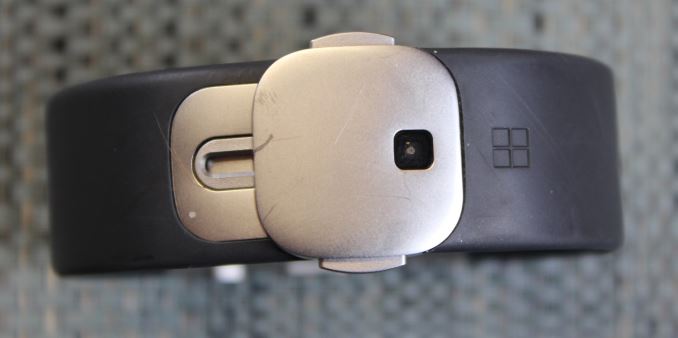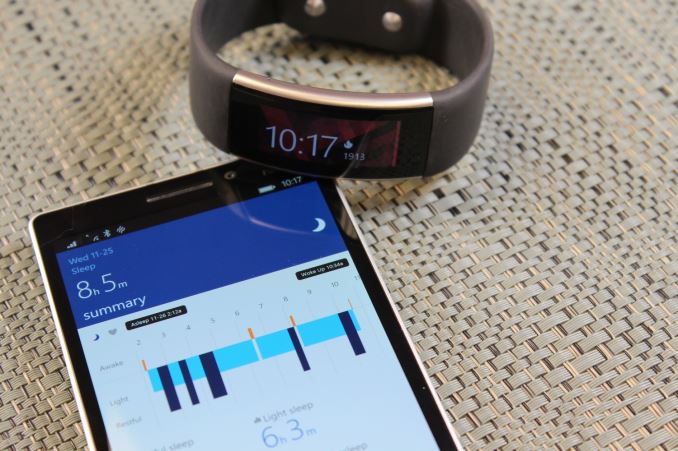The Microsoft Band 2 Review
by Brett Howse on November 30, 2015 8:00 AM EST- Posted in
- Wearables
- Microsoft
- Microsoft Health
- Microsoft Band
Final Words
I think Microsoft has done a great job on improving the Band over the first generation. The styling and comfort levels have gone way up from the black plastic first generation model. The new curved screen is exactly what the Band needed to fit a wrist more easily, and Microsoft took note that many people wore the Band with the screen on the inside, and modified the Band to work better that way. Moving the batteries from the straps to the clasp has also made the strap a lot more comfortable, and the new material is great.
Where the Band excels is in fitness tracking. Fitbit and others have a strong hold on this market, but they don’t have the cloud infrastructure like Microsoft to be able to integrate with other vendors, and to store and manage data as easily. As a fitness band, the Microsoft Band 2 is at the top tier of devices available, with enough sensors to track many metrics. The built-in GPS makes it a great companion for runners, hikers, or bikers, and the generic exercise function is a nice catch-all for pretty much any other fitness activity you want to track. It will estimate your VO2 Max while running, and if you are serious about fitness this is a great device.
It also doubles as a pseudo-smartwatch, with obvious things like a clock included, but it will run apps right on the Band as well. Eventually this is going to be merged into Windows IoT, but for now it’s a custom firmware with custom apps. If this fit into the Universal Windows Platform you could see even more potential, but for now the limited processing power of the Cortex M4 is put to good use with built-in functions that fit well into the idea of the Band, plus third party apps which can expand the capabilities. You can do Smartwatch-style tasks like read and respond to messages, get notifications right on your wrist, and even pay for Starbucks.
It's a pretty limited smartwatch though, with truncated messages and no real sense of a symbiotic relationship with the Smartphone. It’s instead another device, which syncs through the phone but is otherwise standalone. That’s great for running, but it would be great to be able to control music playback on your phone, or to be able to clear notifications on the Band which then clears the same ones on the phone. At the moment it’s further from a smartwatch than I would like.
This kind of speaks to the target audience as well. Really, the Band is targeted to people who are into fitness, and those who want to track their activities. Fitness and I have a love/hate relationship, and wearing the Band becomes a lot less useful when you don’t want to use most of its functions. For those looking for a Smartwatch, they would likely be better suited somewhere else.

At $249, the Band has gone up in price since the first genration’s $199 price, but the redesigned styling and addition of a barometer likely make it worth it, at least for those not already invested in the ecosystem. It’s in the same ballpark of pricing as similar devices that are targeted towards just fitness, so it’s nice to get the extra functionality of the Band as a bonus on top. Microsoft was pretty smart to make this a cross-platform device as well, since their own foray into the mobile world has not been as successful as they would have liked. The Microsoft Band 2 would make a great companion to anyone into fitness or golf, which is really what it is targeted at. Those who are looking for a smartwatch that works with Windows Phone also only have this option, and the capabilities of it are mostly directed towards fitness, where it excels.











56 Comments
View All Comments
ronnybrendel - Tuesday, December 1, 2015 - link
Can you use Microsoft Band 2 with an Android Phone? If so, are there differences to using it with a windows phone?ronnybrendel - Tuesday, December 1, 2015 - link
nvm. I'm hesitant to install apps with that many permissions and upload my health data to someone elses computer.errorr - Friday, December 4, 2015 - link
The penalties for HIPAA violations are such that I assure you your info is much safer than most other types of cloud storage. MS has had to build Azure and Health from the ground up with HIPAA and HITECH restrictions in mind.This also includes a 30 day legal obligation to inform you of an accidental or malicious disclosure and comes with associated fines.
There is a whole bunch of info on their website about compliance and auditing...
Miller1331 - Tuesday, December 1, 2015 - link
Great review, maybe worth picking up in the holiday salessonci - Tuesday, December 1, 2015 - link
Why people say smartwatches are expensive, I got an Armani, its more expensive and it only shows time..designerfx - Tuesday, December 1, 2015 - link
So, garmin watch: 2-4 weeks battery life.Microsoft band: 48 hours.
Jawbone: 1 week +.
Why would anyone accept 48 hours again?
Spivonious - Friday, December 4, 2015 - link
GPS burns battery. Jawbone has no GPS, and Garmin is rated at 8 hours with GPS active.I have the Band 1 and with GPS going on a full charge, I can get 6-7 hours. 2-3 days if no GPS. Remember that this is a lot more than a pedometer.
beginner99 - Wednesday, December 2, 2015 - link
I will probably be one of the last person to buy such a thing, I was late to mobiles, late to Smartphones and also not really getting the smartwatch thing. To make this work for me, I want the wearable to be able to communicate with the phone over a pretty large distance, like 100-200 meters. Maybe that already works but AFAIK Bluetooth is limited to maybe 10 meters or so? Anyway, the point is that you can leave your ever larger phone lying in your office, backpack,...and get notifications and stuff without having to put the huge phone in your pocket. Same for fitness. I can put the phone in the locker and communication remains intact.marvdmartian - Wednesday, December 2, 2015 - link
Here's an improvement I didn't see, while skimming the article; a more robust charging port. A friend of mine went through three of the original MS bands, within a year's time. The sole reason was that the charging port kept going bad on the devices....and if you can't charge them, they're useless.And while I have no idea how this type of device stacks up against, say, a FitBit band, feature-wise, I do know that if they're close, chances are better that the FB band will be purchased, at a $75 to $150 price band, over a $250 MS band.
Spivonious - Friday, December 4, 2015 - link
I haven't had issues with mine (Band 1) and it's gone through the washing machine.